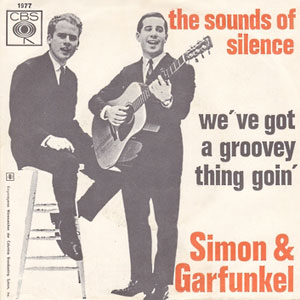

"The Sound of Silence" by Simon and Garfunkel is a classic song essentially tied to an era of young, counter-cultural Americans but full of such artistic depth and aesthetic beauty that it is timeless in its appeal to music fans of all ages. This is the song that propelled the folk duo, Simon and Garfunkel, to stardom in 1965.
Structure
Most songwriters think of standard song-structure as verse, chorus, verse, chorus, bridge, chorus or some variation on that. "The Sound of Silence," however, goes a little something like this: verse, verse, verse, verse, verse. That's right! Five verses. This kind of form is known as strophic. The melody is basically the same for each of the five verses. It's like a hymn where the harmony and melody stay the same but the lyrics change for each repetition.
Lyrics
The song tells a story. There is a beginning, middle, and end. Without a strong, interesting story to take us through the repetitive musical form, the song might be very boring. But, the strophic musical form can lend itself very well to story telling because our attention is not being pulled away from the lyrics by new musical ideas. Whenever a new musical idea comes in, it may take focus off of the lyrics. In this song the music is fit for the lyrics. The music serves the lyrics, and the story draws us into the song. Also, important to remember is that each verse ends with what might be thought of as the "hook." The words, "the sound(s) of silence," conclude each verse, and those words fit logically into the idea of each verse. That's not easy to do!
Here's my simplified summary of the story-concept structure:
V1 Introduction of the vision and greeting to the darkness to which the singer is singing.
V2 Description of the vision. Narrow streets, cold and damp, a flash of neon light.
V3 Finally, the important thing, the conflict, the disturbing image of people living a half existence oppressed in silence.
V4 Next, the poet or singer speaks out against the indifference to wake people from their apathy and unthinking worship
V5 The people continue to worship their idol, and then the warning comes from something Beyond the multitude and the poet. Its words are a biblical allusion to the "writing on the wall" and the "still small voice" of the Lord.
More Simplified Still:
V1 Intro
V2 Beginning of explanation, (setting)
V3 The conflict is shown
V4 The hero tries to help in vain.
V5 A warning from Beyond (no resolution for the people in the vision; only a lesson for the audience)
So the easy part of writing a song like this is what we have just looked at: the clever structure. The hard part is having the compelling story concept. And, with that, I cannot help. We all must keep reading, dreaming, and living if we want to find inspiration.